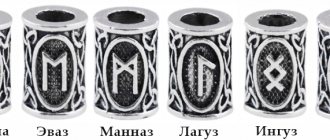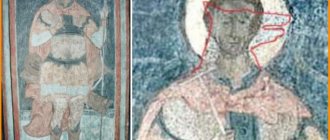Glagolitic and Cyrillic are the ancient alphabet of our ancestors - the Slavs. Of course, before their creation, attempts were made to some kind of systematization, but they did not reach the level of a full-fledged alphabet. The ancient alphabets Glagolitic and Cyrillic became, if not the first, then the most important steps in the development of writing. Basically, their appearance is associated with the development of religion. After all, sacred texts were written down and transmitted. Unfortunately, all information about the Glagolitic and Cyrillic alphabet still remains a big question. All we know today is that not all scientists accept and agree with the facts. For example, the same seemingly resolved questions: when exactly did the Glagolitic alphabet appear? Was it earlier or later than the Cyrillic alphabet?
Let's not go into the smallest details. Let’s just briefly talk about what the Glagolitic and Cyrillic alphabet are. Go!
Is Cyrillic more ancient than Glagolitic, or vice versa?
As you know, in matters of the origin of these alphabets, not everything is so clear. But most of all, the controversy flared up over precedence: did the Glagolitic alphabet come first or the Cyrillic alphabet? More facts for the first one. Here they are:
- The most ancient monuments of literature (for example, the legendary Kyiv leaflets) are written in the Glagolitic alphabet.
- Ancient palimpsests (writing tablets) contain texts in Cyrillic, but it is clear that they were inscribed after erased texts in Glagolitic.
- Western written sources, where Cyril and Methodius read sermons, are written in Glagolitic.
- The Glagolitic alphabet is more complex both in the design of the characters and in the rules for their use. The Cyrillic alphabet is simpler in this regard. That's probably why it was created.
Slavic alphabet Glagolitic and Cyrillic: an excursion into history
The origin of the Cyrillic and Glagolitic alphabet is shrouded in secrets, riddles and discussions among scientists. But we will all try to highlight the main points.
You can read more about the Glagolitic alphabet, its creation and structure in the article “The Glagolitic alphabet is the oldest writing system among the Slavs.” We will focus more thoroughly on the Cyrillic alphabet.
The Cyrillic alphabet literally gave life to the alphabets of many Slavic languages: Russian, Bulgarian, Belarusian, Serbian, Ukrainian and others. And it appeared around 863 thanks to the brothers Cyril and Methodius. Emperor Michael III of Byzantium pushed them to this great step with his order. The original purpose of the new alphabet was to organize and translate the Greek scriptures. Before the advent of the Cyrillic alphabet, the Slavs, of course, used writing. But the alphabet for them was either Glagolitic or borrowed Greek or Latin.
If we talk about the structure of the alphabet, then the classical Old Church Slavonic Cyrillic alphabet was a set of 43 letters, and 24 of them made up the entire Greek alphabet. And the remaining symbols were simply necessary: after all, the Greek and Slavic languages are different in pronunciation! Interestingly, numbers could be written using letters in both the Cyrillic and Greek alphabet. If you remember that the Glagolitic alphabet was a kind of counting: from 1 to 9, from 10 to 90, from 100 to 1000 and so on.
Thus, the Glagolitic and Cyrillic alphabet have their own history, unique and special. It cannot be said that any of them is worse or better. After all, both of them are a stage of history, this is the evolution of writing. The Cyrillic and Glagolitic alphabet, the creation of which did not take a couple of hours, are the embodiment of colossal human labor. After all, it is not possible for everyone to put all the richness of a language into a few dozen characters.
Glagolitic and Cyrillic: similarities and differences
These two alphabet symbols are similar in sound and names. They are also both ancient Slavic writing systems. Cyrillic and Glagolitic have the following differences: for example, the letters in Glagolitic are very complex in writing (style), they are more rounded and ornate. The Cyrillic alphabet contains those letters that we are all accustomed to from school. What is the difference between the Cyrillic alphabet and the Glagolitic alphabet, besides this? Of course, by the time of appearance, as well as by its “fate”. If the Glagolitic alphabet was forgotten (although there is evidence that its echoes can still be heard somewhere), then the Cyrillic alphabet, as already mentioned, gave rise to many alphabets in the world.
If we compare the Cyrillic and Glagolitic alphabet, we can say the following:
- The Cyrillic alphabet was created on the basis of the Glagolitic alphabet and the Greek language.
- The style of characters in the Glagolitic alphabet is more reminiscent of the ancient one.
- And the style of Cyrillic characters and their pronunciation are close to modern ones.
- Glagolitic and Cyrillic letters could be used to write numbers and numbers.
Examples of Cyrillic and Glagolitic writing: “Kiev Leaves”, Novgorod Manuscripts, “Kiev Missal”, “Prague Passages”, “Rheims Gospel”, “Book of Prophets”, “Zograph Gospel”, Boshkan Plate are written in Glagolitic. All later texts were already in Cyrillic.
You can talk about the two ancient alphabet Glagolitic and Cyrillic for hours. This is truly a very interesting and fascinating topic. Why are we talking about these ABCs? It would seem that we have our own alphabet, we don’t need anything else. However, we must not forget that the modern alphabet taught at school is a modification of the Cyrillic alphabet. But without knowing about the past, it is difficult to develop. Without knowing your roots, your descendants and their culture, you will never be a full-fledged and worthy member of society. The writing that Cyrillic and Glagolitic gave to the entire Slavic world is still alive. Every day, when we read and write something, we don’t think about it. But the appearance of our own alphabet is a huge step for the development of the entire society and the individual.
The dispute over the priority of the Cyrillic or Glagolitic alphabet is politicized
Since the 19th century, the idea has been firmly rooted among linguists that the creators of the Slavic alphabet first invented the Glagolitic alphabet. It has earned its right of birthright in comparison with the Cyrillic alphabet, if only because the oldest Slavic manuscripts are written in its original alphabetic system. However, not everything turns out to be so simple. The issue becomes even more confusing - politics is mixed with philology.
A dark question is the existence of “pre-Cyrillic” writing among the ancient Slavs. Most likely they had
- pictography,
- picture letter,
just as every nationality at the level of the primitive communal system had it. At a later time, they may have used runic writing.
Theories of the origin of the Glagolitic alphabet
It is known for certain that it was the Glagolitic alphabet that was created by Saint Cyril, Equal to the Apostles. There is even reason to believe that in ancient Russian the Glagolitic alphabet was called “Cyrillic”. There are several theories about the origin of Glagolitic characters. There is an opinion that these letters were created by Kirill on the basis of some ancient “Slavic runes”. Despite the fact that there is not a single serious evidence in favor of this theory, it has its followers.
It is also believed that the appearance of the letters of the Glagolitic alphabet coincides with Khutsuri - the ancient Georgian church letter. If this is so, then there is nothing strange in this - it is known that Cyril was well acquainted with eastern writings.
Until the 19th century, there was a theory in Croatia that the author of the Glagolitic alphabet was not Cyril, but Saint Jerome, a church writer, creator of the canonical Latin text of the Bible, who lived in the 5th century AD. Perhaps the theory was brought to life by the fact that the Slavic population of Croatia sought, with the help of the authority of a revered saint, to protect their alphabet and their language from forced Latinization imposed by the Roman Catholic Church, which at the Council of Bishops of Dalmatia and Croatia in 1056 called the Glagolitic “Gothic scripts invented a certain heretic Methodius." In Croatia, the Glagolitic alphabet is used in church books to this day.
LiveInternetLiveInternet
Quote from message -KRASOTA-
Read in full In your quotation book or community!
Glagolitic and Cyrillic
Glagolitic and Cyrillic are ancient Slavic alphabet.
The origin of the Glagolitic alphabet remains a matter of debate. Attempts to bring the Glagolitic alphabet closer to Greek cursive (minuscule writing), Hebrew, Coptic and other writing systems did not yield results. Glagolitic, like the Armenian and Georgian script, is an alphabet that is not based on any known writing system. The letterforms correspond to the task of translating Christian texts into the Slavic language. The Baschanskaya (Boshkanskaya) slab is one of the oldest known Glagolitic monuments, 11th century.
The first letter of the alphabet has the shape of a cross, the abbreviated spelling of the name of Christ forms a symmetrical figure, etc.
Some researchers believe that the Glagolitic letters are based on the cross, triangle and circle - the most important symbols of Christian culture. The Cyrillic alphabet is based on the Byzantine charter letter. To convey sounds that were absent in the Greek language, letters were used borrowed from other sources. The question of which of these alphabets is the oldest has not been finally resolved, but most researchers believe that Cyril created the Glagolitic alphabet, while the Cyrillic alphabet has more later origin. Glagolitic "Zograph Gospel", X-XI centuries.
The oldest Glagolitic manuscripts come from those areas where Cyril and Methodius worked (Moravia) or their disciples expelled from Moravia (southwestern regions of the Bulgarian kingdom).
The oldest Cyrillic texts were written in the east of the Balkan Peninsula, where there was no direct influence of the Solun brothers. Late Glagolitic text page (20th century)
Glagolic monuments are more archaic in language.
There are errors in Cyrillic texts, indicating that the text was rewritten from the Glagolitic original. There is no evidence that Glagolitic manuscripts could have been copied from Cyrillic ones. Cyrillic alphabet: Novgorod birch bark letter No. 591 (1025-1050) and its drawing
Parchment, the writing material of the Middle Ages, was quite expensive, so they often resorted to writing new text in an old book. The old text was washed off or scraped off, and a new one was written in its place. Such manuscripts are called palimpsests. There are several known palimpsests where the Cyrillic text is written in the washed-out Glagolitic alphabet, but there are no Glagolitic texts written in the washed-out Cyrillic alphabet. If the Glagolitic alphabet was created by Cyril, then the Cyrillic alphabet, in all likelihood, was created in Eastern Bulgaria by the Preslav scribes. Almost everywhere the Cyrillic alphabet has replaced the Glagolitic alphabet. Only the Croats living on the islands of the Adriatic Sea used Glagolitic liturgical books until recently.
The Cyrillic alphabet is used by those of the Slavic peoples who professed Orthodoxy. Writing based on the Cyrillic alphabet is used by Russians, Ukrainians, Belarusians, Serbs, Bulgarians, and Macedonians. In the 19th–20th centuries. missionaries and linguists based on the Cyrillic alphabet created writing systems for the peoples living on the territory of Russia. In Russia, the Cyrillic alphabet has undergone a certain evolution. At the beginning of the 18th century. Peter I carried out a spelling reform, as a result of which the letters of the Cyrillic alphabet acquired new styles. A number of letters were excluded whose sound meaning could be expressed in another way. From that time on, secular publications were typed in the reformed alphabet, and church books in traditional Cyrillic.
In the middle of the 18th century. the letter E was added to the civil seal, and in 1797 N.M. Karamzin introduced the letter E. The Russian alphabet received its modern form as a result of the spelling reform of 1918. In the mid-1930s, it was planned to create a new Russian alphabet on a Latin basis. However, this project was not implemented Antiques From books History of words Symbols
What are the similarities and differences
Based on the Glagolitic alphabet and the Greek alphabet, Cyril's student Kliment Ohridski, who worked in Bulgaria, created the alphabet that we today call the Cyrillic alphabet. There is no difference between the Glagolitic and Cyrillic alphabet either in the number of letters - in the original version there are 41 of them in both alphabets - or in their names - all the same “az”, “buki”, “vedi”...
The only difference is in the lettering. There are two forms of Glagolitic script: the older, round one, known as Bulgarian, and the more recent, angular or Croatian.
The numerical meaning of the letters does not match either. The fact is that in the Middle Ages, the Slavic peoples, like the Greeks, did not know Arabic numerals and used letters to write numbers. In the Glagolitic alphabet, “az” corresponds to one, “buki” to two, and so on. In the Cyrillic alphabet, numbers are tied to the numerical values of the corresponding letters of the Greek alphabet. Therefore, “az” is one, and “vedi” is two. There are other discrepancies as well.
The author of the medieval Bulgarian treatise “On Letters,” Chernorizets Khrabr, wrote about the Slavic alphabet, its advantage over the Greek and the fact that it has undergone improvement: “The Slavic letters have more holiness and honor that a holy man created them, and Greek ones - the Hellenes filthy. If anyone says that they have not done well because they are still finishing them, let us say this in response: the Greeks also finished them many times.”
What did Cyril bring to the Old Church Slavonic alphabet?
The basis of the Old Church Slavonic alphabet was Greek letters, to which Cyril added nineteen “new” letters. As the Slavic writer of the early 10th century Chernorizets Khrabr wrote in “The Tale of Writing”:
“Before, the Slavs did not have books, but they read and told fortunes with the help of lines and cuts, being pagans. When they were baptized, without equipment it was difficult for them to write in the Slavic language in Roman and Greek letters... and this was the case for many years... Then the philanthropic God sent them Saint Constantine the philosopher, called Cyril, a righteous and faithful man, and he created for them thirty letters , others in accordance with (the needs of) the Slavic language.”
What's older?
Until recently, it was believed that the Cyrillic alphabet is older and this is the same alphabet that was created by the brothers Cyril and Methodius. Glagolitic was considered a later system that arose as secret writing. However, at present, science has established the point of view that the Glagolitic alphabet is older than the Cyrillic alphabet. The oldest Glagolitic inscription with exact dating dates back to 893 and is located in the temple of the Bulgarian king Simeon in Preslav. There are other ancient texts dating back to the 10th century that were written in the Glagolitic alphabet. The antiquity of Glagolitic inscriptions is indicated by palimpsests - manuscripts written on a used sheet of parchment from which an older text was scraped. There are many palimpsests where the Glagolitic inscription has been scraped off, and Cyrillic is written on top, and never vice versa. In addition, Glagolitic texts are written in a more archaic language than Cyrillic ones.








